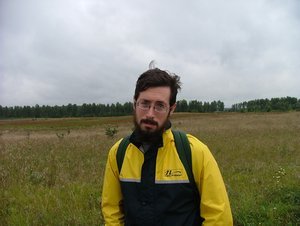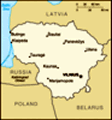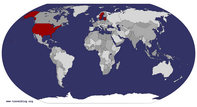Advertisement
Published: September 12th 2009

 Where are we again?
Where are we again?
Even my hair looks confused.In keeping with our desire to see a national park in each country, we’d mentally marked down this as the day to make a trek out to Aukstaitija National Park. However, at the last minute we chickened out of the 2-hour bus trip that would drop us several km away from the park, and decided to visit Trakai National Historic Park instead, a preserve on a peninsula that was a mere 40-minute train ride out of town. With two castles, a ton of lakes, and an obscure sect of Judaism calling it home, we figured it would be the perfect fit, and if we could manage to catch the 7:45 AM train, we might even make it back by early afternoon.
We got up early and booked it to the train station, making it there with plenty of time to spare. Graham was sitting near the window, so he had station-spotting duty. Unfortunately not all of the stations were very well-marked. We got about thirty minutes into the journey and figured we must be getting close. We passed Lentvaris. A few minutes went by. Suddenly Graham looked out the window and said, “This is it,” and we grabbed our stuff

 Snail!
Snail!
One of our wonderful traveling companions. Couldn't keep up with us, though.in a hurry. As we got off the train, I said, “This doesn’t look very peninsular to me.” I took a look at the station house, an empty one-room affair. “Senoji Trakai,” it proclaimed.
Old Trakai. Uh-oh. You might think that of two towns with the same name, the old one should be the one with the castles, but you’d be wrong. Out here it was just two-lane roads and farmland.
We hemmed and hawed about what to do. The next train coming through to “new” Trakai wasn’t for another five hours. I saw two options: wait thirty minutes for our train to pick us up on its way back to Vilnius; or head out and see if we could find our own way to Trakai. We sulked for about five minutes and then decided on Option 2. We headed out front to look for a taxi. Hah! In Old Trakai (population: 3) there is no market for a taxi and probably nobody to drive it either. But soon we spotted a road sign:
TRAKAI 5km
Thank goodness. Okay, 5K was a bit more than we’d planned on walking before actually getting to see something interesting, but at

 Trakai Island Castle 1
Trakai Island Castle 1
Graham resting on a Lithuanian national treasure. Hey, *they* weren't using it.least it was manageable. And there was even a pedestrian/bike path to walk on!
We saw a sign:
Entering .
I said, Maybe will have coffee! We passed three farm houses and saw the next sign:
Exiting .
Okay, maybe not.
We saw several tall wooden statues sitting in people’s yards near the street -- all similar, suggesting they must be part of some public works project. I want my government to install public art in my yard! No, wait, I
totally don’t. As one friend said when she saw the artwork in her 2007-issue passport, it is pretty clear our government doesn’t have a Department of Taste.
Finally we came to a roundabout with another sign:
TRAKAI 3km
We followed the arrows at the roundabout and wound up on a much less pleasant road, one that seemed to be under heavy construction. (Thankfully, the construction workers had Sunday off.) Everything was jerry-rigged: half of the street was only one car wide, with sometimes steep drops on either side, so every so often we saw hurriedly-placed stoplights gating traffic through the area. Amazingly there

 Trakai Island Castle 2
Trakai Island Castle 2
Erin and another view of the castle.was still a bike lane... sort of. It didn’t feel as safe as the previous street. There were no fun statues, just grassland. We passed an archaeological preserve. “It’ll be around that next corner,” Graham said. We passed another archaeological preserve. “Over that hill,” Graham said. We passed an entrance to a nature preserve. We passed several people walking the other way. “See,” said Graham, “there are people. They must be coming from somewhere.” “Yes, and they’re all going somewhere else,” I said pointedly.
Finally we saw signs of a town -- some houses, a church. It still didn’t look very peninsular. We got close enough to read the sign:
Entering LENTVARIS
What the...? Lentvaris was the train stop
before Old Trakai! We turned around and saw the companion sign behind us:
Exiting LENTVARIS
TRAKAI 6km
?*@#&%!$(MISSING)^!.
We thought about calling a taxi, but: see Old Trakai. We thought about hopping the train from Lentvaris, but: see no trains for 5 hours. (Well, 4, by that point.) We thought about sitting down and moping ourselves to sleep, or maybe that was just me. Eventually we sighed, downed some water like

 Trakai Island Castle 3
Trakai Island Castle 3
Erin and the castle interior. The exhibit rooms here went on FOREVER, and 20% of them were souvenir shops.it was hard liquor, and turned around to sulk our way back to the roundabout.
45 minutes later, we got to the roundabout. The Trakai sign still pointed stupidly toward Lentvaris. We frowned at it aggressively. It persisted.
We looked at the other spokes of the roundabout. I noticed a gas station down one and we went there to see if we could find a map. The maps were useless and confusing, but as we left the gas station, we spotted a sign along the highway above us advertising food and lodging. Well, we reasoned, where there’s a B&B, there’s a tourist town. Can’t be more wrong than either of the other options, at least. As soon as we got to the top of the rise, we saw the sign:
Entering TRAKAI
We were greatly cheered, though our feet were tired and sore after 10km of misdirection. We began to see signs of life: billboards advertising restaurants; the train station; and finally, two big lakes. At long last -- Trakai!
We finally set down our tired bodies for some hot lunch at a restaurant 2km up the peninsula offering traditional Karaim food. The
Karaim are a

 CHAOS ENSUES
CHAOS ENSUES
A battle royale encountered at the Swan Family residence.tiny group of fundamentalist Jews, many of whom were “brought to Lithuania” by one of its dukes in the 15th century or so and subsequently served as palace guards. I wondered idly why someone of this era would be voluntarily increasing religious diversity and Graham pointed out that “bringing a group to Lithuania” sounded better on a placard than “finding and enslaving a group too small to protest.” Well, at some point Lithuania did gain a real reputation for religious tolerance, with Jews, Muslim Tatars, and Orthodox, Catholic, and Uniate Christians all sharing space and enjoying some measure of self-rule. At this point the Karaim are beyond endangered (one wonders how they fared under the Nazis and the Soviets) but there are still several dozen in Trakai.
Food never tastes so good as when you are bone-tired and cranky. We both ordered meat pies in a flaky crust -- so delicious; Graham got a salad and I got some potato croquettes; and there was coffee. Sweet, sweet coffee. When we sat down I couldn’t imagine ever walking again, but after good food and an hour of rest, we were in fine shape for some real sightseeing.
We headed first to the Island Castle, which was just around the corner. The setting of this castle is just beautiful, sitting serenely in a bird-filled lake, one island among many. We saw tons of other tourists -- some touring the castle on foot, some enjoying the lake in paddleboats and canoes. We saw a couple of young buskers playing tunelessly on plastic recorders, and a dozen or so souvenir merchants hawking amber necklaces and linen napkins. I think this may be the first place we’ve seen where tourist season isn’t over.
The castle itself, like most in the region, was ruined at some point in the last six centuries but was rebuilt according to drawings and paintings from the period. It’s made of red brick built on a stone foundation. Both of us liked the brick arches that were everywhere in the interior. Although the architecture was neat, the museum inside the castle was slightly cheesy, with some over-the-top American-style displays. Still, there were some neat exhibits. Probably the most salient point to me was that Lithuanian nobility, at least post-Christianization, strongly followed the fashions of Western Europe -- in terms of dress, in terms of artifacts like china and furniture. It makes sense (especially given that Lithuania has not always ruled itself alone). But it hadn’t really occurred to me before that nobility is kinda uniform and that if you want to see interesting cultural differences, you’ve gotta look at the peasants. Most of Lithuania’s preserved cultural heritage comes from the 19th century -- perhaps the nationalism of that age is why; perhaps the push to establish or maintain a Lithuanian identity is what encouraged people to start saving artifacts and images of how commoners lived.
We left the castle and spent some time on the shore, trying to clear our museum-head. When we got back to the main peninsula we saw some folks feeding a bunch of the shore birds. The stars of the show were a family of swans -- two adults, presumably the parents, and some cygnets who had reached adult size but were still a downy grey (mute swans only turn white during their first winter). It was fascinating to watch the parents as a ragtag group of mallards tried to duck and dodge their way toward the food. While the cygnets seemed unbothered by the ducks, hissing only at their siblings, the parent swans behaved incredibly aggressively toward the mallards, hissing and snapping constantly to scare them off. I don’t blame them; mallards are pretty much jerks. Another person came up to the shore with a small dog, and at that point ALL the birds freaked out. I giggled to myself at the idea that a Yorkie with its hair in ribbons could be a threat to anybody.
Our heads cleared, we wandered into one more museum -- a small collection of cultural artifacts maintained by the Karaim. This three-room museum raised more questions than it answered. Given that the Karaim have their own language, which uses an Arabic script, why were most of the religious texts in Hebrew? (Turns out we were wrong about the Arabic script. Silly guidebook.) If this tiny group mostly worked as guardsmen for many decades, how is their customary dress so ornate? And why didn’t we see any mention of World War II? Well, museums can’t all be winners. We headed to a chocolateria for a little self-indulgence before rushing to the next train back to Vilnius.
Our last night in town was quiet; leftovers for dinner (never has there been a better night for leftovers) with a quick stop at a pancake shop to write postcards over some very nice tea. As a great bonus, the Hot Water Fairy had visited us overnight and we were even able to take showers. We love you, Hot Water Fairy!
Advertisement
Tot: 0.089s; Tpl: 0.013s; cc: 6; qc: 45; dbt: 0.0432s; 1; m:domysql w:travelblog (10.17.0.13); sld: 1;
; mem: 1.1mb








